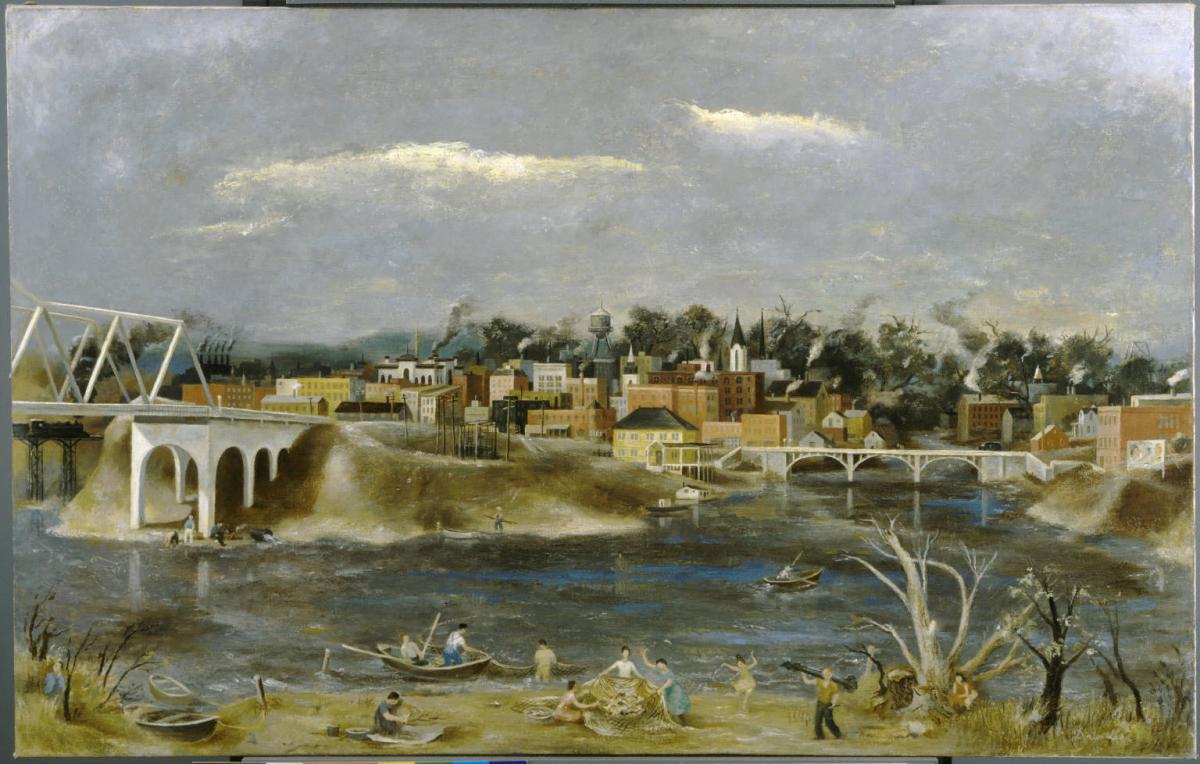Illinois River Town
Doris Lee ( c. 1938 )

Illinois River Town reflects America’s industrial advancements in the later years of the Great Depression. Smoke rises from buildings as vehicles cross one of two bridges into town, and young people fish along the shores of the Mississippi, a scene the artist recalled from her childhood.[1] Lee painted from memory, sketching individual subjects before assembling them in her composition. Illinois River Town takes inspiration from an untitled 1930 photograph of Ottawa, Illinois, by Russell Lee. Several of the church steeples and the Wagon (left) and Fox River (right) bridges are landmarks of the town.[2] Lee’s dedication to accurately depicting the engineering of the two bridges may be linked to her great-grandfather’s work in construction on a bridge in Keithsburg, Illinois.
Illinois River Town was first exhibited at the 1938 Carnegie International and acquired by Duncan Phillips in 1939. In written remarks on the painting, Phillips notes: “This is an attractive and undiluted American landscape which has been based on a genuine enthusiasm for the prints of Currier and Ives. Miss Lee knows her subject at first hand and paints it both with enjoyment of detail and design and with technical gusto.”[3]
Text by Rebecca Shipman as part of the Seeing U.S. Research Project
[1] Mary Jane Appel, “Doris and Russell Lee: A Marriage of Art,” Journal of the Illinois State Historical Society 111, no. 4 (2018): 82–121.
[2] Appel, “Doris and Russell Lee.”
[3] Duncan Phillips notes on Illinois River Town. Phillips Collection Archives. Exhibition History and Catalogue Record
Born in a small rural community in western Illinois near the Mississippi River, Doris Lee became part of an artistic community in New York in the 1930s that included Stuart Davis and Yasuo Kuniyoshi. Her paintings are often filled with personal subject matter rendered in a representational style that synthesized Renaissance painting, European modernism, and American folk art.
In Illinois River Town, Lee re-imagines the Midwestern cityscape of her youth with humor and drama, akin to Brueghel and sixteenth-century Dutch landscapes. A lively scene of fishermen occupies the lowest register of the painting, cut off from the industrialized town by the broad horizontal expanse of river. The geometry of the buildings in the quaint town, along with the bridges and the classically arched pier that juts into the river, contrasts with the curvilinear forms of the figures and trees on the riverbank. During the Depression, Lee’s paintings were popular for their decorative qualities and positive emphasis on American experience.